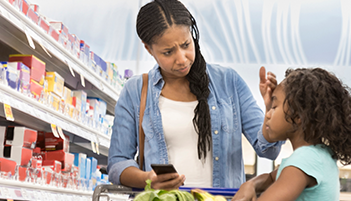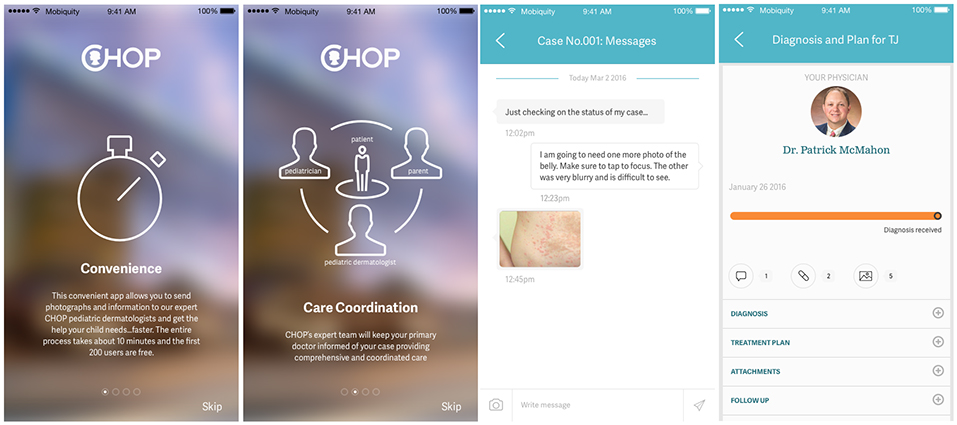HOW CAN WE HELP YOU? Call 1-800-TRY-CHOP
In This Section
Did a New App Facilitate Faster, Easier Dermatology Consults for Families?

The findings:
Nobody enjoys sitting in a doctor’s waiting room, especially when they have an uncomfortable skin condition. A Children’s Hospital of Philadelphia study team tested a direct-to-consumer mobile app designed to facilitate routine dermatologic consultations for children and adolescents. The pilot study results showed the telemedicine technology was acceptable, easy to use, and expedited care.
Of the 198 cases submitted, 193 were diagnosable through the app. The turnaround time for a dermatologist to accept the case, send a diagnosis, and provide instructions to the patient was about 2.8 hours. Eighty-eight percent of the app users surveyed said this response was faster than expected or as expected. Approximately 90 percent of users agreed that they would be willing to use the app again and recommend it to friends and family.
Why it matters:
Appointment wait times for pediatric dermatology office visits often exceed several months. New approaches such as mobile phone-based teledermatology may offer more convenience and streamline access to care for a broad range of families. Yet studies are needed to determine how best to integrate virtual consultation into pediatric care. This is the first pediatric study to evaluate a store-and-forward mobile app that enabled parents to submit cases for dermatological complaints, including relevant medical history and images, through their smartphones.
Who conducted the study:
CHOP’s division of Dermatology developed the app and involved families of patients, ages 6 weeks to 21 years old, from three primary care sites who had enrolled in CHOP’s online patient portal. Lead author, Alexander G. Fiks, MD, MSCE, associate director for outpatient research activities at CHOP’s Clinical Futures, research coordinator Lindsay Berrigan, MPH, and experts from CHOP’s department of Biomedical and Health Informatics, including Linda Fleisher, PhD, MPH, conducted the evaluation along with CHOP dermatologist Patrick McMahon, MD. CHOP’s Office of Entrepreneurship and Innovation supported the app’s development.
How they did it:
The study team developed the app over a six-week period in accordance with telemedicine standards set by the American Academy of Pediatrics and American Academy of Dermatology. The free app and consultation were available to families who received invitations by email or referral to participate in the study.
During the pilot period, 197 parents and one adolescent securely submitted a skin complaint case. They uploaded photographs of the skin condition and responded to questions for a pediatric dermatologist to review. If needed, the dermatologist requested more information or photographs. The app users received a notification on their mobile device with the dermatologist’s diagnosis, recommendations, and any appropriate prescriptions were sent to the pharmacy.
Screenshots from a new app under development and testing by CHOP researchers that enables parents to submit images of their child's skin conditions through smartphones to a dermatologist for faster diagnosis.
Immediately following their telehealth experience, all app users had the opportunity to complete a voluntary online survey. They received a second voluntary online survey five to seven days later. The study team collected and analyzed data from the two surveys and from app usage logs captured electronically.
Quick thoughts:
“Through telehealth, including the use of carefully developed and evaluated mobile health apps such as the one studied, CHOP may more effectively support families in receiving timely, high quality care,” Dr. Fiks said.
What’s next:
Although the study team purposely invited varied demographic groups to participate in the study, the results showed that the majority of survey respondents were white, highly educated, and had previous experience using a mobile device to look up health information or use the Internet to communicate with their physician. The authors suggest that additional efforts may be needed to encourage families from traditionally underserved groups to use teledermatology apps.
Where the study was published:
Telemedicine Journal and e-Health
Where to learn more:
The mHealth Research Affinity group at CHOP is available to help guide and inform ongoing and future research focused on mobile app development, feasibility, testing, and implementation.



